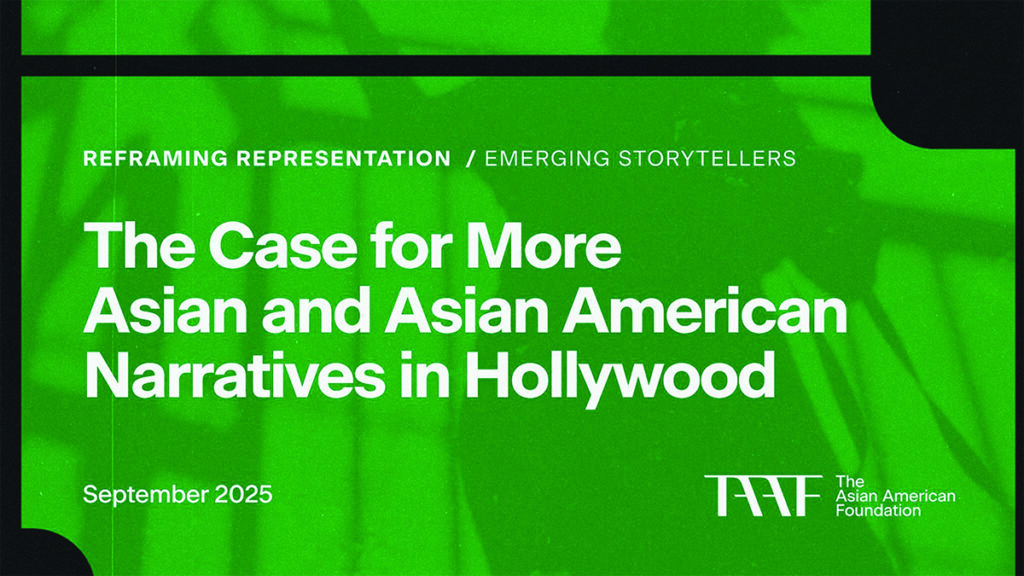By Kai Curry
NORTHWEST ASIAN WEEKLY
 The Asian American Foundation (TAAF) has released a report that demonstrates the importance—and the lucrative potential—of Asian American stories in TV and film. Called “Reframing Representation: The Case for More Asian and Asian American Narratives in Hollywood,” the report aims to be a roadmap for both Asian Americans and non-Asian Americans. Backed by months of data and research, the report offers advice to creators as to how to frame their pitches, and arguments to industry investors as to why they should say “yes.”
The Asian American Foundation (TAAF) has released a report that demonstrates the importance—and the lucrative potential—of Asian American stories in TV and film. Called “Reframing Representation: The Case for More Asian and Asian American Narratives in Hollywood,” the report aims to be a roadmap for both Asian Americans and non-Asian Americans. Backed by months of data and research, the report offers advice to creators as to how to frame their pitches, and arguments to industry investors as to why they should say “yes.”
To compile “Reframing Representation,” TAAF engaged with multiple sectors, including government, nonprofits, creators, and filmmakers. As TAAF spokesperson Andrew Peng explained, without a profit incentive, studios will not invest in Asian American stories. Even with the recent success of shows such as “K-Pop Demon Hunters” and “Beef,” Hollywood needs convincing.
According to the report, when asked, 42% of Americans cannot think of a famous Asian American. Nor can they think of a film with an Asian American or Asian actor. For most people in the U.S., martial arts films are still the first and maybe only genre that comes to mind. The statistics have not changed much over the years, in spite of what appears to be an increase in representation.

Sruthi Chandrasekaran, director of Data and Research at TAAF.
“It feels like we’re at a turning point,” said Sruthi Chandrasekaran, TAAF’s Director of Data and Research. There is a need to take stock of where we have been, and where we can go, Chandrasekaran continued. That is where “Reframing Representation” comes in. The report includes a timeline, for instance, which details the progress of Asian Americans in Hollywood, starting with the “Dawn of Hollywood” in 1922, when film great Sessue Hayakawa left Hollywood due to being typecast and stereotyped (negatively); and continuing to 2018’s “Crazy Rich Asians,” and other prominent releases, which are under the category of “Cracking the Dam.”
“We have experienced a wave of Asian and Asian American representation in U.S. film and TV like never before, but we’re still at the starting line,” suggests the report.
“Reframing Representation” goes on to discuss why seeing oneself on the TV or film screen is important. It goes much further than a warm fuzzy feeling or a role model to look up to—it’s essential to a feeling of belonging and even to one’s safety. According to one statistic, 63% of Asian Americans feel unsafe in their communities due to their race. This insecurity comes with a lack of a sense of belonging, which for Asian Americans, the report says, is closely linked to representation. There’s more, though. When Asian Americans do see themselves, they want it to be authentic. Not just TAAF’s report, but also Nielsen has shown that when media perpetuates (negative) stereotypes, it also has a role in perpetuating violence. More than this, when people are invisible on screen, they are invisible off screen. This causes lack of consideration by non-Asians and lack of self-esteem in Asians.
“This work is borne out of the impetus to create more belonging for our communities,” said Chandrasekaran. There is, in fact, a plethora of opportunities, she continued, to see more Asians on the screen in new and more relevant roles, to go beyond the tropes, and even to create cultural icons.
“[The marketplace wants] new points of view. New experiences,” said Hieu Ho, as quoted in the report. Ho is the co-founder and partner at Imminent Collision, and is known for producing Randall Park in “Shortcomings.” One of the points that Ho and the report makes is that these stories do not have to be centered around race. They could be anyone’s stories, yet by including Asian American actors, there will also be an Asian American nuance.
“The framing we use is ‘universal themes tied to fresh perspectives.’ Where the perspectives happen to be Asian American—being Asian American isn’t the entirety of what’s fresh, but a part of it,” said Ho.
The TAAF report offers advice to creators as to how to pitch their stories and also lays out five reasons as to why investing in Asian American stories promises to be lucrative. First, Asian Americans are investing, too. They consume English media, and are projected to spend over $1 million more than the average U.S. household in their lifetimes. Asian Americans in the U.S. have $1.3 million in buying power.
Second, Asian Americans are engaged in media, all kinds of media. They allocate the most TV time to streaming of any group, and they tend to show up at the movie theaters as well, even more so if the movie features an Asian American actor or story.
Third, Asian American intellectual property such as graphic novels are exploding, and those are making their way to TV and film. They are more Asian American protagonists in these areas, and there are more Asian American writers making a name for themselves.
Fourth, just look at the recent Emmys or Oscars—Asian Americans are winning. 2023 saw nine Asian Oscar winners; 2024 saw “Everything Everywhere All at Once” dominating, with Michelle Yeoh winning Best Actress and Ke Huy Quan winning Best Supporting Actor for his role in the same film.
Fifth, audiences want diverse programming. “The system is stuck, but the appetite for breakthrough is bigger than ever,” said a senior-level executive interviewed for the report.
“Reframing Representation” walks through all the stages of development of a story—the why’s and the how’s, production, marketing—and is aimed at people inside and outside of the entertainment industry.
“Hopefully, the data that we have around how Asian American content can be profitable, how there is an appetite…not just from the Asian American community, but also from others…can be used by folks who are trying to pitch and sell their stories to see success,” said Chandrasekaran. The report will be widely disseminated and also discussed at key events, such as film festivals. “There’s definitely a very strong market here.”
Kai can be reached at newstips@nwasianweekly.com.



